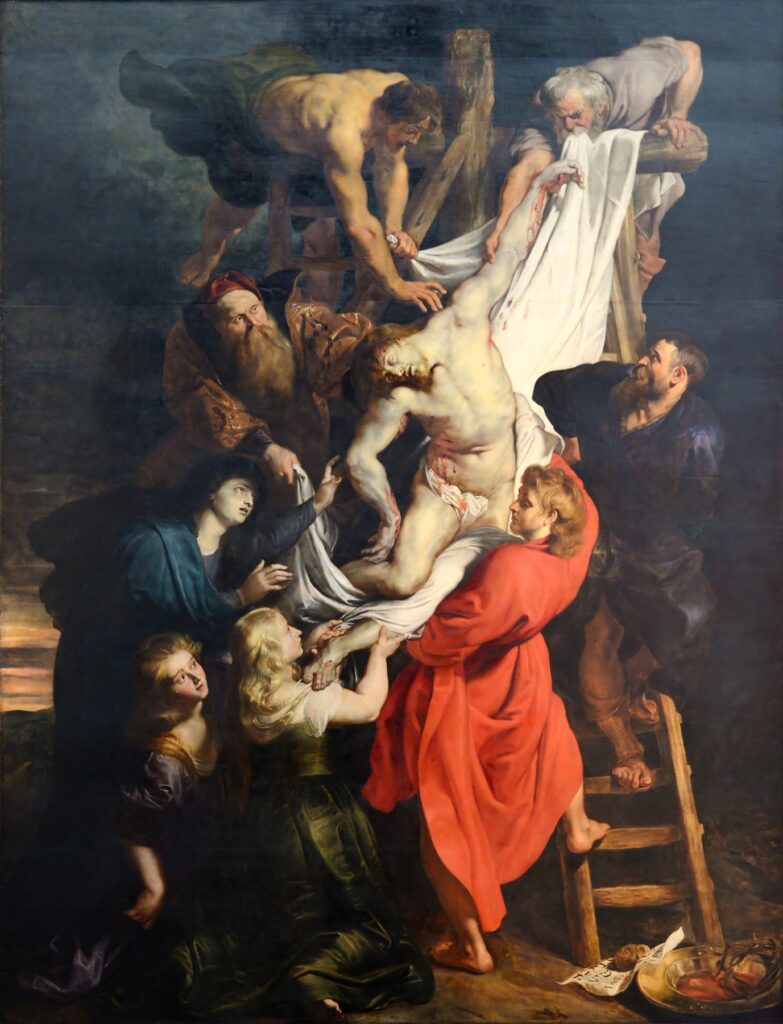
For this month’s column, Suffolk-based Artist, Educator and Presenter Grace Adam, gives a timely appreciation of the human form in art – ahead of teaching life drawing classes at Saltgate Art in Beccles
I feel I should whisper this, but I’ve never been a big Rubens fan. Last year I went to Antwerp and encountered The Descent from the Cross by Peter Paul Rubens, and that changed.
The Descent from the Cross, Peter Paul Rubens, 1612-14

We are immersed in fleeting images on our phones and screens, so when something stops you in your tracks and makes you look and look, it’s quite humbling.
For as long as there have been bodies to draw and paint, humans have drawn and painted them. We are invested in and fascinated by the operation, appearance, and status of the body: ours and our fellow humans’. If you want to know anything about a society; its belief systems, attitudes to women and to men, sexuality, or spirituality, take a look at the way it records and mythologises the human body. The human body is invariably a vehicle for messaging.
Commissioned by the city’s Guild of the Arquebusiers (Musketeers) in 1611, Rubens set about this vast work as part of a triptych. Catholic painters of the period were required to appeal to their audience emotionally as well as spiritually, so Rubens hypes up the composition, the colours, the expressions. The dramatic configuration is almost unfeasibly intricate with the faithful helping to lower a lifeless body from the cross. Eight people are jig-sawed together into an ellipse framing Christ’s limp, but muscular body. They heave pull and support, creating extraordinary curves and geometries. The white shroud against the dark threatening sky adds to the drama. Look how the man at the top grips the fabric between his teeth to free up his hands. Mary, in the Catholic tradition of the counter reformation is elevated from weeping mother to key player. A gruesome little still life occupies the bottom right corner.
Whatever you believe or don’t believe, this is about human sorrow. Rubens is a master of emotional communication. It’s bizarrely flamboyant, as well as psychologically sophisticated. Four centuries after he put brush to wood, it still works.
Trace, Jenny Saville, 1993/4

Painter Jenny Saville is influenced by Rubens and talks about his “incredible feats of painterly engineering”. Trace by Saville couldn’t be more different really. Not heroic, glamorous or sensual, this is more like the reality of the bodies we occupy. After unwrapping and unstrapping, the marks of bra, knickers and waistband remain. This a body with weight and narrative and history. Turned out hands and pinched in elbows make this feel as if the model is lying down. Her back fills the entire canvas, close to the viewer and larger than life-to be inspected.
Millions of renderings of we humans exist, some meant to elevate the human form to almost godlike status, some meant to bring us back down to earth and remind us of ordinary. Saville, as a woman painting a woman avoids the clichés, and reclaims the female body. We are so used to seeing artificial ‘perfection’ from Renaissance Italy to TikTok, it’s a bit odd to see mundane flesh.
Just like so many painters down the centuries, Rubens and Saville have made monumental and moving works. Maybe Rubens’ painting and Saville’s painting have more in common than at first glance. Both painters tell us about what it is to be human.
Fancy trying your hand at Life Drawing or getting back into it? Everyone welcome. I’ll be teaching a new class in Beccles starting on June 3rd Drop me a line: grace@graceadam.com.
Grace Adam teaches at the National Portrait Gallery and Chelsea College of Arts, and is a co-presenter on The Art Channel (watch the latest review: Marina Abramović at the Royal Academy of Arts). Life Drawing with Grace Adam at Saltgate Art, Beccles, every other Monday, starting June 3rd, 6-8pm. All levels welcome. Friendly fun and inclusive. All materials and equipment included.









I attended the first class at Beccles, and Grace is a fantastic teacher! The classes are fun and relaxed, and the old cinema provides a beautiful setting. I look forward to the rest of the course, and throughly recommend it to anyone who is thinking about giving it a go.
Thank you Danie! Looking forward to our next session
Grace